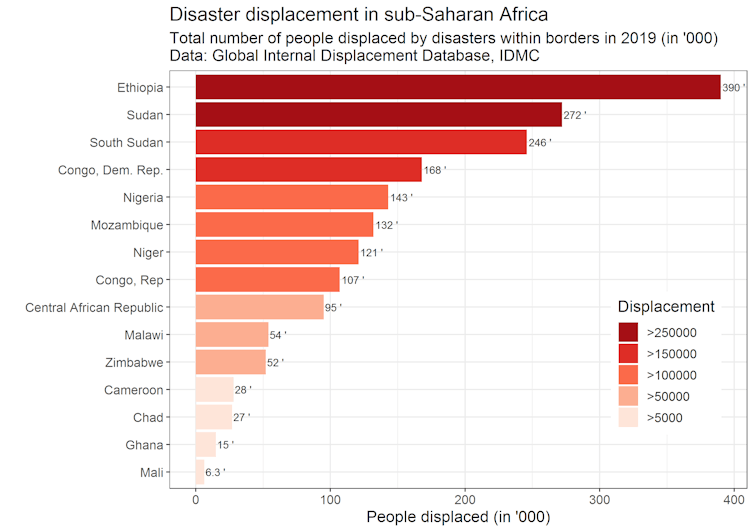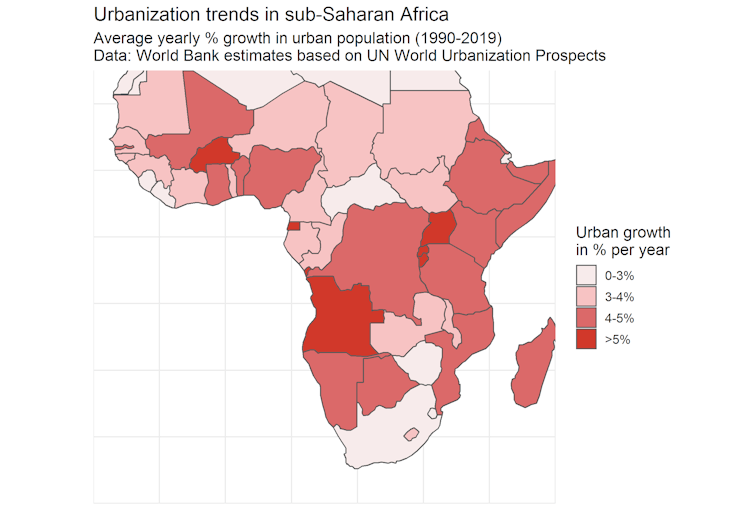The link between climate change and migration has gained both academic and public interest in recent years. Many studies have found that environmental hazards affect migration. But the links are nuanced and depend on the economic and sociopolitical conditions in the respective regions of origin.
So what causes people to move and where do they go? And what is the relationship between these decisions and changes in climatic conditions?
To answer these questions we conducted a meta-analysis to systematically analyse previous findings in the literature on environmental migration. We combined evidence from 30 country-level studies that estimated the effect of slow-onset and rapid-onset environmental events on internal and international migration worldwide. This allowed us to explore migration drivers and to identify hotspots where climatic and other environmental factors likely exert a strong influence on migration.
Our findings underscore the complexity of what lies behind people’s decisions to migrate. We found that migratory responses differed depending on the local conditions of affected populations. For example, environmental migration was most pronounced in agriculturally dependent and middle-income contexts where populations have sufficient resources to migrate. In low-income contexts, on the other hand, people were more constrained in their mobility and faced the risk of getting trapped in harsh environmental conditions.
Often commentators and politicians create the impression that “waves” and “rising tides” of climate migrants are crossing the border to Europe and the US.
In fact, abundant research, including our own study, shows that environmental migration is primarily internal or within a region and rarely over large distances. Instead of focusing merely on numbers, it’s important to understand the actual situations of communities affected by climatic changes to effectively support and protect vulnerable populations.
Sub-Saharan Africa
Our analysis shows that changing climatic conditions and ecological hazards are an important migration driver in sub-Saharan Africa. Some of the threats are slow in the making. These include rising temperatures, desertification, biodiversity loss, land and forest degradation. On top of this is the increasing frequency and intensity of extreme events such as floods and droughts, which have led to major displacements in the past years.

For households exposed to environmental stress, migration can serve as an important livelihood and adaptation strategy, particularly in rural areas. Often it’s individual household members who migrate in an attempt to open new and diversify existing income sources.
Most environmentally induced migration is internal – or within a region – with a large share of migrants turning towards urban centres, as seen in the map below. This has its own risks and challenges, particularly in sub-Saharan Africa, which already has the highest proportion of urban population living in informal settlements, 53.6% in 2018 according to UN HABITAT, the UN Human Settlements Programme.

In the past decades, several cities in sub-Saharan Africa have seen rapid population growth and are today among the fastest growing in the world. Cities that already host several million people, such as Dar es Salaam in Tanzania, Kampala in Uganda, Abuja in Nigeria, Ouagadougou in Burkina Faso and Bamako in Mali, are expected to double in size by 2035. The rapid urbanisation has significant implications. It brings new opportunities as well as risks.
Urbanisation challenges
The rapid, and often unplanned, nature of the urbanisation process in many countries has led to several challenges. These include inadequate infrastructure, housing, and a strain on the provision of public services such as health care, education and transport.
While migrating to an urban area offers opportunities for migrants, it comes with risks. Many migrants entering cities from rural areas have limited resources and are highly vulnerable. In the hope of a better life, many end up in deprived and marginalised neighbourhoods with poor access to water, sanitation, and public services.
Having fled from environmental threats in their origin regions, climate migrants may find themselves exposed to new hazards in their urban destinations. Many informal settlements are located on marginal land in risk areas. Due to the low quality of construction materials in these areas, the inadequate infrastructure and high population densities, disasters can have fatal consequences.
Urban floods, in particular, are a major challenge. For example, in 2018, six of the ten largest flooding events that triggered displacement were in sub-Saharan Africa, and urban areas bore the greatest impacts. Also this year, severe floods across the region affected several hundred thousand people and led to severe damage and displacement.
Going forward
Climate migration is already a reality for many people and will continue to be. The World Bank Groundswell report projects that up to 86 million people could be forced to migrate within their own countries by 2050 to escape the slow-onset impacts of climate change in sub-Saharan Africa.
A large share of these migrants will move to cities. If planned and well managed, urban growth has the potential to bring social and economic benefits for both migrants and the destination areas. This will need infrastructural development and inclusive economic policies.
For adequate preparation, it’s important to understand why and under which conditions people migrate and where they go. For this, climate change predictions need to be more strongly integrated in migration scenarios. Better data and comprehensive research on migration dynamics can improve policy-making and raise awareness.
From The Conversation
Author – Roman Hoffmann, Postdoctoral researcher, Potsdam Institute for Climate Impact Research







